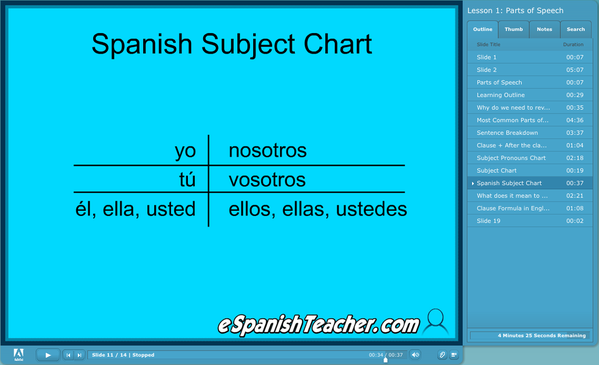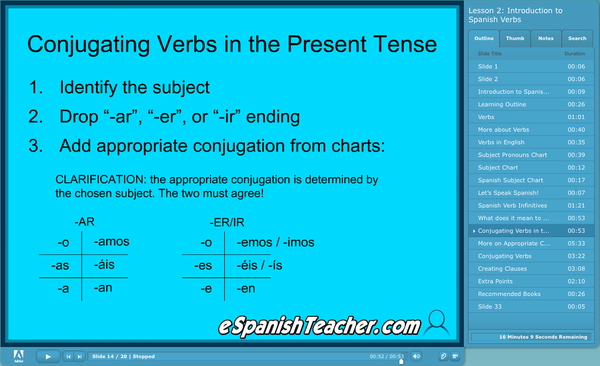|
One verb that should become part of your vocabulary very quickly is poder. Poder is the Spanish verb that means to be able to. This might not sound like the typical Spanish verb to you and you'd be right. It's not easy to image poder like is to run, to eat, to write. Some verbs are very visual and can be imagined easily. Poder is not one of these. It actually falls into the category with other vague verbs such as to have, to be, to know, etc. Another way to look at is is that poder is the verb that means to can, such as I can, she can, you can.
You may have heard the phrase Si, se puede, which comes from the verb poder. Essentially this phrase means Yes, you can or You can do it! It's common in Spanish to have someone say this as a form of encouragement. Here is a breakdown of how the verb is conjugated and it's translations into English: Yo puedo - I can Tú puedes - You can (informal) Él puede - He can Ella puede - She can Usted puede - You can (formal) Nosotros podemos - We can Vosotros podéis - You guys can (informal) Ellos pueden - They can (group of men or mixed) Ellas pueden - They can (group of women) Ustedes pueden - You all can (formal) When the verb poder is used, it is typically followed by another verb. This is because we normally say You can [verb], like in You can run, You can eat, You can write. So in Spanish, you'll want to follow the conjugated form of poder with an unconjugated verb. To see what I'm saying, here are some examples of sentences using the verb poder: Usted puede hablar. = You can speak. Nosotros podemos tocar la música. = We can play music. Yo puedo cantar. = I can sing. Vosotros podeís estudiar. = You guys can study. Spanish verb conjugation is perhaps the most crucial concept for beginner students. So much of what new students learn centers on understanding how to conjugate Spanish verbs. This is because verbs and subjects are the foundational elements of sentence structure and therefore are the foundation of virtually everything you say in Spanish. It’s no different for English—by the way—we just don’t often realize it.
Subject Pronouns or Subjects In Spanish, conjugating verbs is simple, but it does require some explanation as well as a good deal of verbal practice before you’ll understand it completely. Conjugating verbs always begins with the subject of the sentence because we need to know who is acting out the verb. You may hear your Spanish professor refer to subjects as 'subject pronouns', but I think that term confuses people. In my simple mind, they are subjects and it doesn't need to be any more complicated than that. So the subject is the noun (person, place, or thing) that is doing the verb (action word). Common subject are I, you, he, she, it, we, they, etc. Spanish Verbs Verbs are the action word of a sentence, such as run, eat, play, speak, etc. Usually verbs are simple to imagine in your mind. For example, it’s easy to imagine someone running, eating, playing, and speaking. These would all be examples of verbs in their infinitive (pure) form: to run, to eat, to play, to speak. Spanish Verb Conjugation Conjugating verbs requires that you match a subject with a verb. And the most important thing to remember is that the subject determines how the verb is conjugated. When you conjugate a verb, you remove the to and replace it with a subject. In other words, you actually change the verb from its infinitive form (to eat) to a conjugated form when matching it up with a subject. You also sometime change the ending of the verb slightly, such that He + to eat becomes He eats. Or She + to run becomes She runs. This is the essence of verb conjugation, which is the foundation of the Spanish language. It may seem simple in English, but conjugating in Spanish actually presents a couple more challenges because 1) it’s not your native language and 2) the conjugations are much more complex than simply adding an “s” to the end of each verb. This is a quick blog post meant to help you understand the basics of conjugating verbs in Spanish. For a more in-depth look at this topic, as well as a more personalized explaination, verbal exercises, and instant feedback, check out my Beginner Spanish course.In Spanish, a simple example would look like this: Subject: Ella = she Verb: Comer = to eat Ella + Comer = Ella come = She eats To accomplish the example conjugation above, these are the steps we take: 1) Identify the subject 2) Drop the “-er” ending from the verb Comer. 3) While adding the subject, conjugate the verb Comer according to the subject. You can use this subject chart to identify which ending corresponds to which subject. Also, I've included a chart on conjugating verbs in the present tense for reference. Is it hard to learn Spanish?
As a Spanish teacher I get asked this question very often. How difficult is it to learn Spanish? The answer may surprise you. In short, it depends on a number of factors, but usually isn’t too difficult. Let me explain. The first question you need to answer is why are you learning Spanish and how proficient would you like to become. This is important because if you are learning Spanish for a job in a professional environment, then it’s likely that you’ll need to be nearly fluent in order to excel at that job. However, if you want to learn Spanish so you can speak to your neighbors and your goal is not to be completely fluent, then conversational Spanish proficiency is all you’ll need. Do I need to be fluent in Spanish? Speaking Spanish fluently means that you could go into a doctor’s office and describe most of your body parts in Spanish. It means that you could attend an institution of higher learning, comprehend perfectly the materials that your professors would teach, and write pages on specialized topics in Spanish. But most of us don’t wish to become that skilled in the Spanish language. And despite the claims of many Spanish language products and courses, becoming fluent in Spanish would likely take years of living in a Spanish speaking country and rarely speaking English. More on conversational Spanish Conversational Spanish is not difficult to master. Even the poorest classroom students are able to learn to speak in casual conversations with native Spanish speakers. In fact, many who don’t perform well in traditional classroom settings do extremely well learning languages. This is because learning a second language is similar to memorizing the words to your favorite song. Think about the last time a great song came on the radio. You hear it a few times and before you know it you could sing the lyrics from memory without any help from the band. You may have noticed that each day we hear, see, and use Spanish words, phrases, and popular catch phrases. Chances are you already know a good amount of Spanish. Here are some of the popular phrases used in today’s culture: Adiós = Goodbye Pronto = Hurry up Por favor = Please Grácias = Thank you Si, se puede = Yes we can/Yes you can De nada = Don’t mention it Mi casa es su casa = Please feel at home ¿Cómo estás? = How are you? Buenos días = Good day Hasta la vista = See you next time Mano a mano = Man to man Se habla español = We speak Spanish Learning to speak Spanish is not difficult and becoming conversant in the Spanish language is something that the average person can accomplish. The key is to have a few great resources that can explain the rules of the language, such as grammar books, a Spanish-to-English dictionary, and a friend who speaks Spanish. This way you’ll be able to overcome some of the confusing concepts that surface from time to time. Lastly, make sure you get a good amount of verbal Spanish practice, perhaps through watching the Spanish channel on TV and repeating what you hear, listening to Spanish radio, watching movies in Spanish, or having actual conversations with people who know how to speak Spanish. Learning Spanish is expensive
It’s common to believe that learning a new language is an expensive proposition. You might be surprised to know that there Let’s look at the available options. Books on the Spanish Language First, you could buy an old textbook, regular book, or book on tape. Most of these are written by PhDs who’ve spent years studying, but have never learned to teach the language to regular folks. If you’ve ever attended a college or university, you know exactly what I’m talking about. Professors who are too busy researching and writing that they fail to improve their teaching ability. Spanish language books might set you back anywhere from $10-40, but typically don’t offer much in terms of helping you speak Spanish. Most of these books will have you repeating phrases and vocabulary that have very little real-world application and certainly will not give you feedback on your speaking ability. Additionally, they won’t address your specific questions and definitely won’t help you overcome the topics that are most confusing to you. Finally, Spanish books really don’t provide any opportunities to practice what you are learning via conversation. Private Spanish Tutor or Community Education Your second option is to hire a Spanish tutor or take a community education Spanish course. Working one-on-one with a skilled tutor is effective, but will cost you from $20/hour and up. When I was tutoring high school students in southern California, parents were happy to pay my rate of $60/hour for quality tutoring. A community education course will cost from $80-$400, depending on a number of factors. Factor in as well the time and money you’ll spend traveling to meet your instructors. These options are somewhat effective, but will cost you time and money. Expensive Spanish Language Software Finally, you could purchase expensive Spanish language software and learn from the convenience of your home computer. The consensus on these courses is mixed because it’s difficult to determine which software courses actually teach the student to speak Spanish effectively. One well-known company offers a sleek-looking software package for more than $500 to learn Spanish 1, 2, and 3. I always find it interesting that despited the price tag and appearance of quality, the most expensive courses generate countless negative reviews online. Just do a Google search for “[insert Spanish course name here] course review”. You’ll get lots of result that will give you a better idea what to expect when you fork over hundreds of dollars to learn Spanish. There are countless products that claim to teach you Spanish. Unless you are absolutely convince that a certain product is right for you, don’t waste your money by purchasing expensive and ineffective language programs that won’t help you meet your goals. Look for a Spanish course that is reasonably priced and will teach you to speak Spanish effectively. |
AuthorThis is where we chat about all things Spanish. Feel free to ask a question, challenge me, passionately disagree, or rant about whatever. Just make it interesting. Archives
August 2018
Categories
All
|



 RSS Feed
RSS Feed
